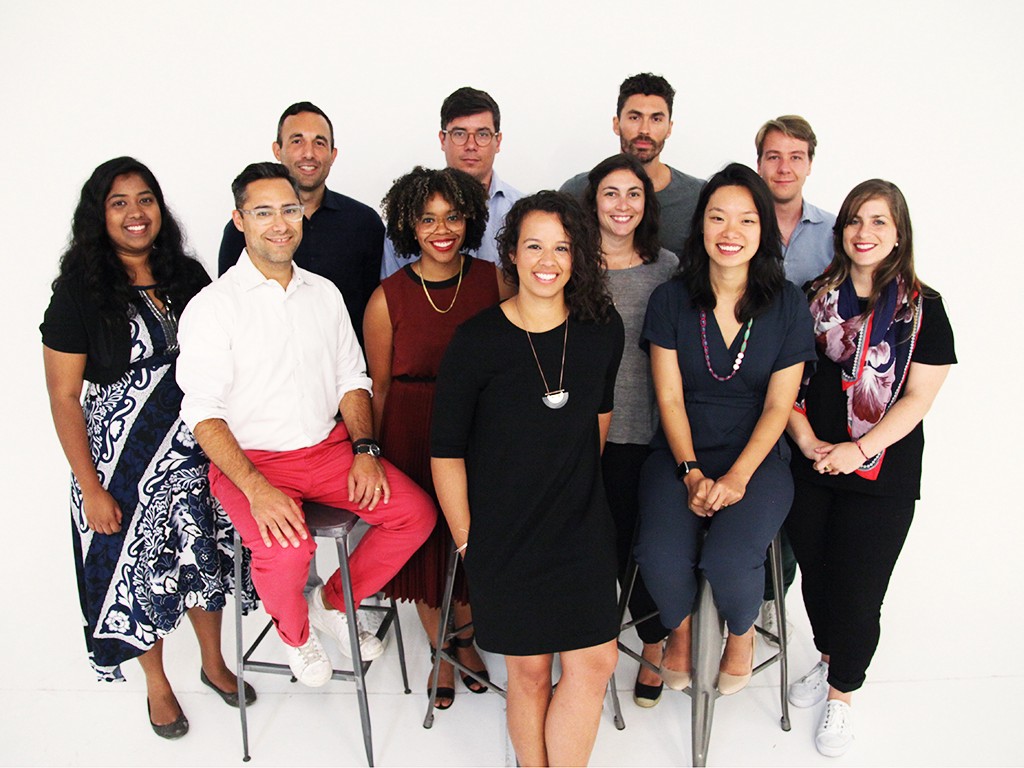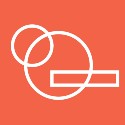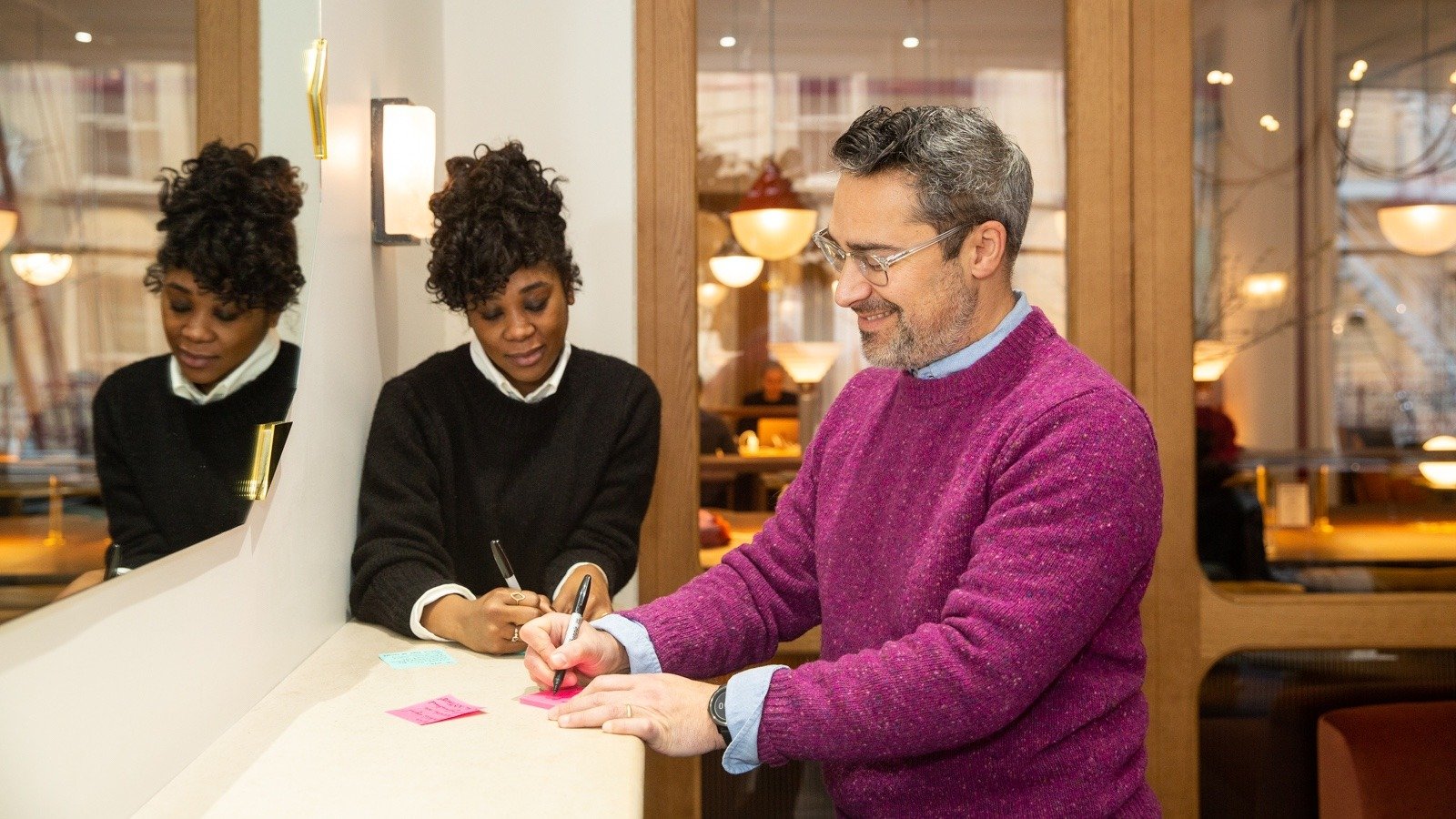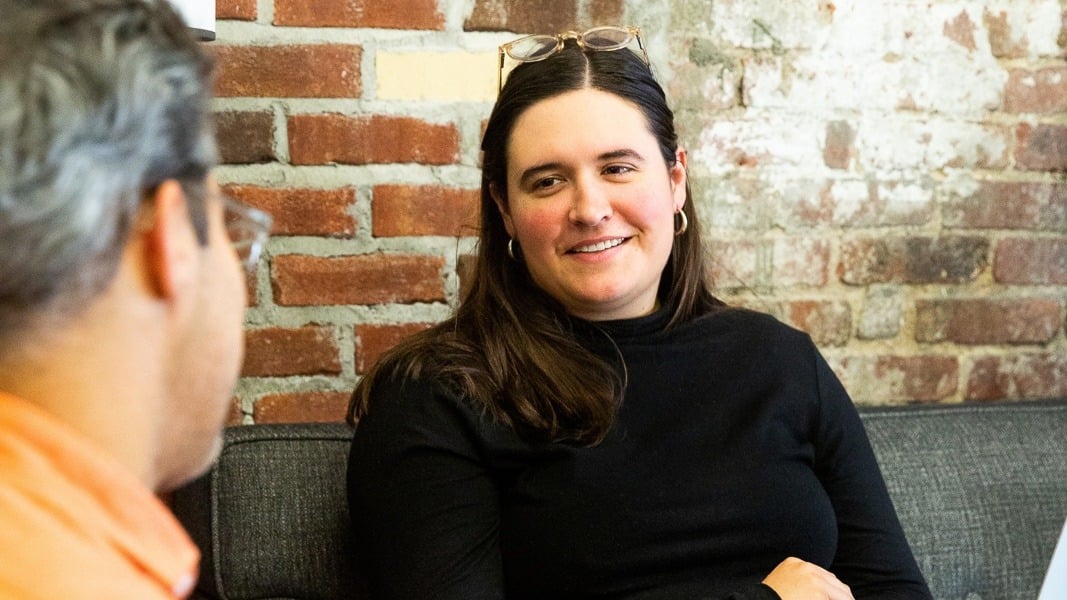Published March 27, 2017 | Updated January 29, 2019 | 20 minute read
A lot has happened since we last shared a detailed update on how things are going at August. In many ways March of 2016 honestly feels like a different world.
Things have gone well. For a company that has a deep belief that the future is impossible to predict, we ended up performing very close to the goals we plotted out for ourselves at the beginning of last year. We attribute this mostly to sticking with a known business model, a familiar and validated offering, and a capable team that had a strong understanding of what was needed to realize the goals we set for ourselves.
We are proud and excited by what we’ve accomplished so far;and at the same time we do not take a bit of this for granted. We still have so much further to go, both in the pursuit of our purpose — a capable team for every meaningful mission — and in simply becoming the kind of business we aspire to be.
Two essential tenets guide us along this journey: default to open and public benefit. We believe that our work is helped by making as much information as easily accessible as possible to others who might share our purpose. With this in mind, here’s what we’ve done over the past year.
Major events and milestones
Team Growth — NY and London
We started the year with a team of 5 founders, based in Brooklyn, NY. Over 2016 we hired 9 new people. 2 of those people left August by the end of the year. In 2017, we’ve already added 2 more additional members, and have another 2 team members joining in April. As of April, we’ll have 16 people on our team, with the intention to still add 1 or 2 more in the next couple months. These numbers seem to be growing fast, but so far we think we’ve managed to keep the team and our culture in synch. Some of our deliberate practices including Summit Week, Onboarding Buddy, shadowing client work, and our 90-day commitment process have all helped us to sustain this pace of growth.
London!
We opened a London office. How quickly this came about belies the significance of this event on our timeline for the past year. A terrific and talented team member came along — Joe Turner — and said that he was game to join us, and we couldn’t imagine a more capable person to help us plant our flag in the UK. So, we jumped at the opportunity and in four months we went from having no business in the UK to having two full-time team members, a four-month client engagement, and a stand-alone legal entity up and running. The London team added its third full-time team member in January, and is actively hiring.
Establishing an Org Structure
As our team and business grew, we had too much work and too many team members to continue running it all as one big team. So, we began to break down the work and divide it into smaller sub-teams, each with their own mission, unique set of roles, and different team members. This transition has served us well, and reaffirmed our belief that optimal team size is 7±2 people.
Constitution
We are a self-governing organization. This means that we have intentionally adopted an operating model where no individual — regardless of their seniority, tenure, title, or anything else — has any unique authority over any other team member, except where that authority has been explicitly granted with the consent of those affected.
A year ago, we were operating this way implicitly, without a firm legal structure or set of rules for everyone to follow. As we grew and added new members to the team, having an explicit reference became a critical foundation for sustaining our self-governing model. At the end of 2016, we began to draft a new constitution to serve this purpose. We have a v0.1 draft of the constitution done now, and are currently operating within it. Our intention is to revise the draft based on what we learn over the next few months, and then to finalize it as a binding legal agreement that will govern our entire corporation.
- Read our draft constitution
- Learn more about our constitution in this episode of August’s Podcast
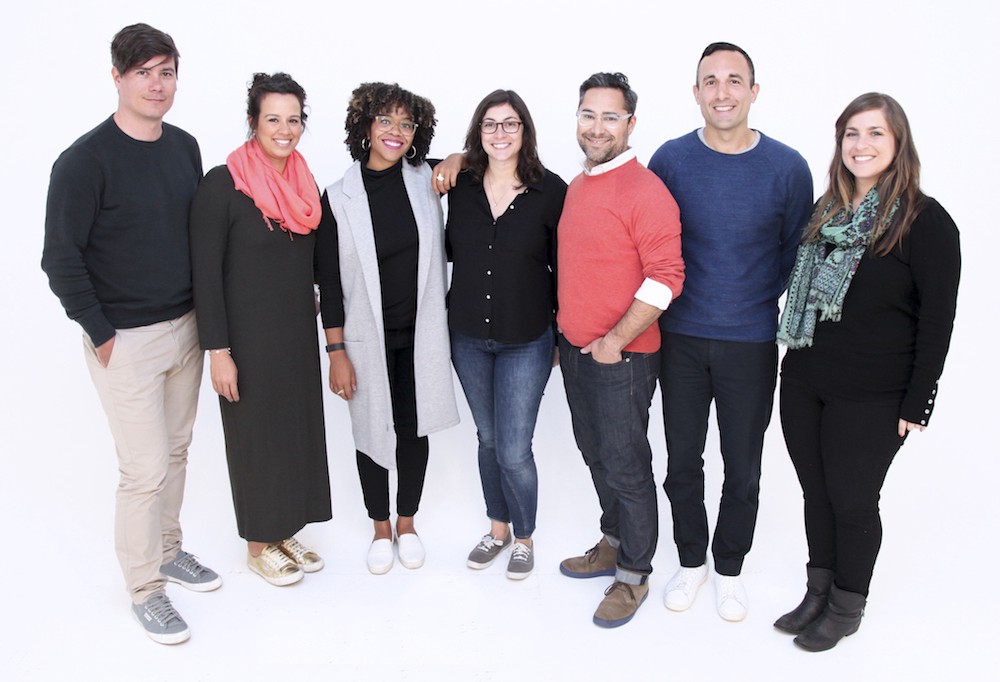
Business Performance
It’s been a year since our last comprehensive update on the state of our business. Our intention is to publish this kind of update closer to every 4 months … but, that didn’t happen. It is worth noting that maintaining transparency takes time. We still believe fervently that it’s worth it, but it is extra work.
So, how’s it been going?
At the end of December 2016:
- 2 offices (Brooklyn & London)
- 12 team members (10 in Brooklyn, 2 in London); all full-time employees; two new members hired in July and August of 2016 left our team before the end of the year.
- Total 2016 revenue: $2.7mm (Brooklyn) + £222,000 (London)
2016 P&L for the Brooklyn office was
- $2,730,576 revenue
- ($1,188,278) salaries + cost of goods
- $1,542,297 Gross
- ($590,589) OPEX
- ($355,000) Bonuses
- $596,707 Net (approx. 22% profit margin)
2016 P&L for the London office was
- £222,000 revenue
- £5,268.37 billable expense income
- £78,466 investment from Brooklyn office
- (£68,390) salaries + cost of goods
- £237,344 Gross
- (£35,926) OPEX
- (£0) Bonuses
- £201,417 Net (approx. 66% profit margin)
Engagements in 2016
Brooklyn
- 13 contracts
- 7 client organizations
- + 3 paid corporate speaking gigs for client organizations
London
- 1 contract
- 1 client organization
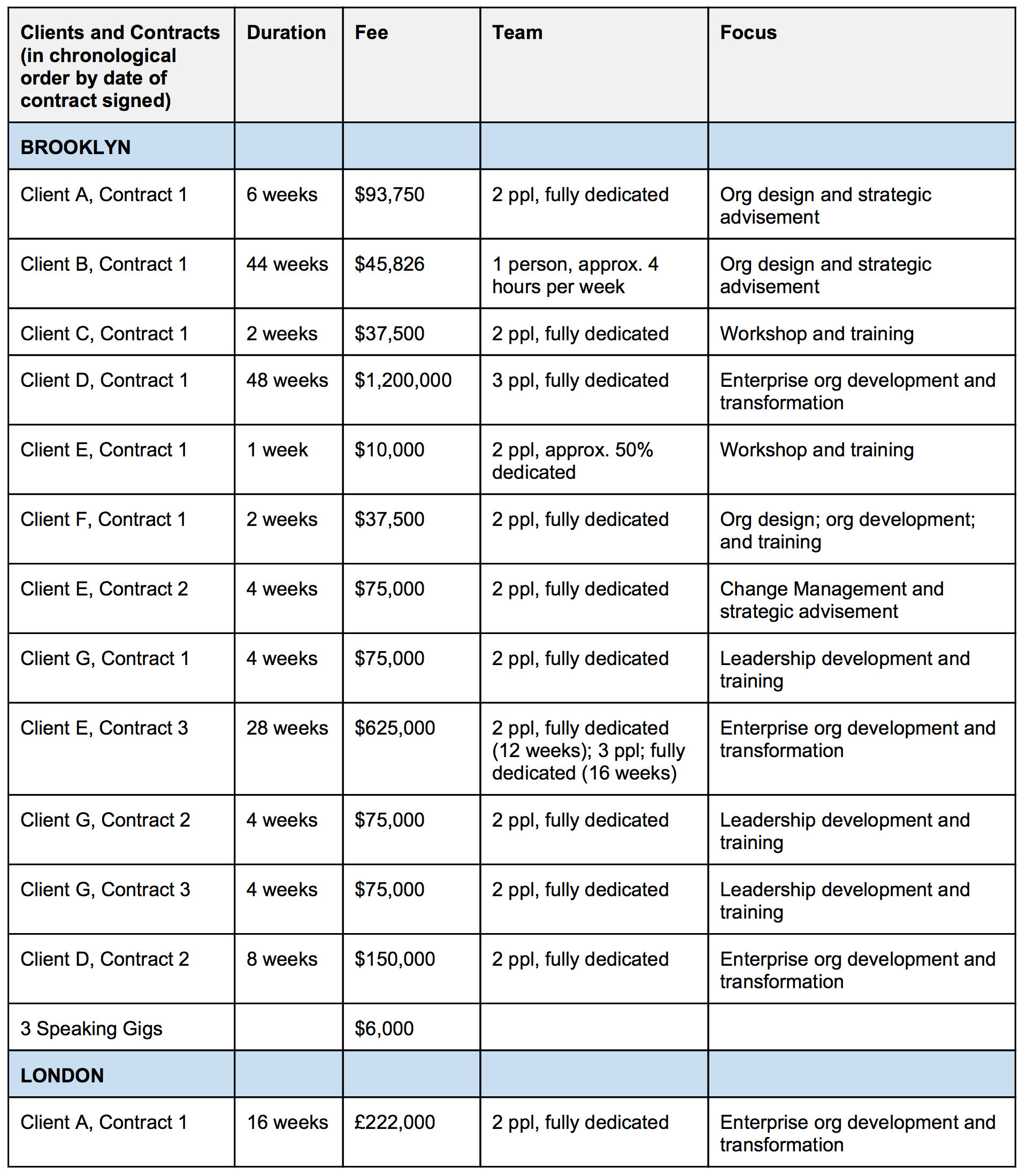
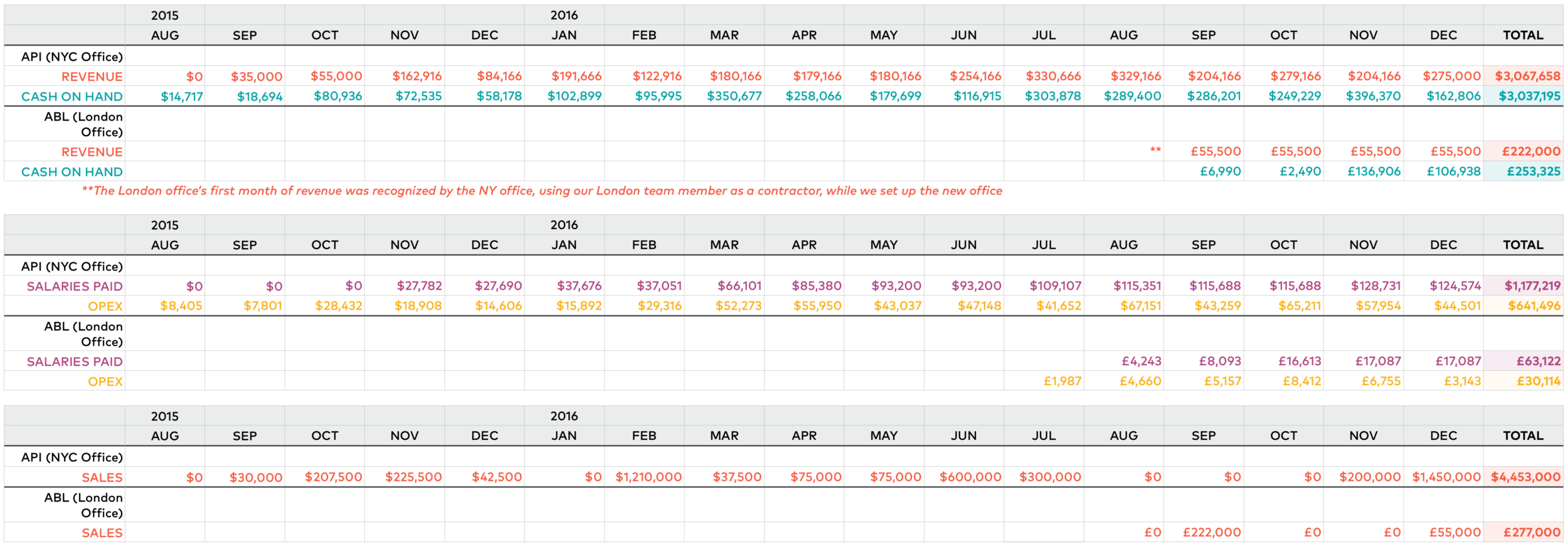
For a deeper dive into our finances, we recommend spending some time with this overview document in our public Google drive.
So far, in January and February of 2017:
Brooklyn
- 4 contracts
- 3 client organizations
- $700,000 in revenue
- +1 new hire (+2 more starting in April)
London
- 1 contracts
- 1 client organizations
- £110,000 in revenue
- +1 new hire
Diversity
We have continued our efforts to grow the diversity of our team. With our newest addition in February, we have 11 members in Brooklyn and 3 in London.
We collect diversity data on our own team using this survey. The diversity of our team is as follows:
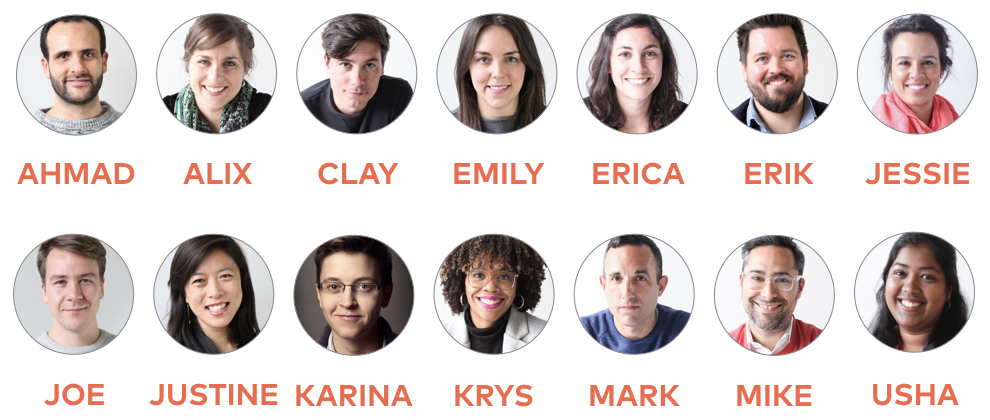








We intend to continue to work on this as we grow. Recently we adopted the following policy as an explicit expectation for all August team members:
Every August team member is expected to help us continuously increase the diversity of our team, the level of inclusion, and the feeling of belonging.
This is just a start. Diversity, inclusion, and belonging is something that takes dedicated, constant, ongoing work. August is committed to this in the long run.
One area of diversity that we haven’t made as much progress on as we would like is the gender balance across different capacity levels (i.e. seniority).
It is important to note a few things that are different — and more equal — at August than at most companies. At August, people at a higher capacity level hold no authority over other team members. No person is excluded from holding any role, including various leadership roles, because of their capacity level. And men and women at the same level make exactly the same amount in salary.
All that said, the higher capacity levels on our team, and the higher salaries that go along with those levels, skew male.
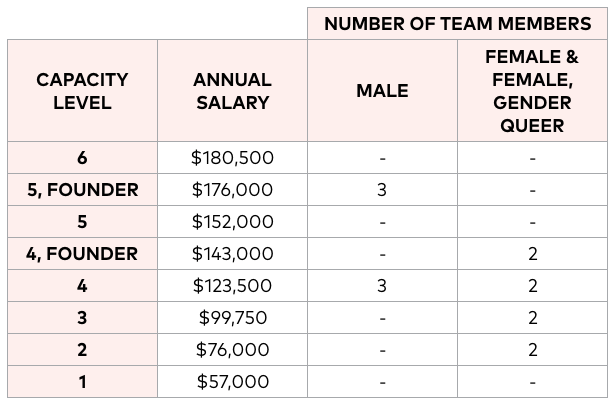
This is something that we are very conscious of, and are actively working to address. Among the ways we’re addressing this is by prioritizing senior women in our recruiting efforts, and in how we are thinking about recruiting for our Board.
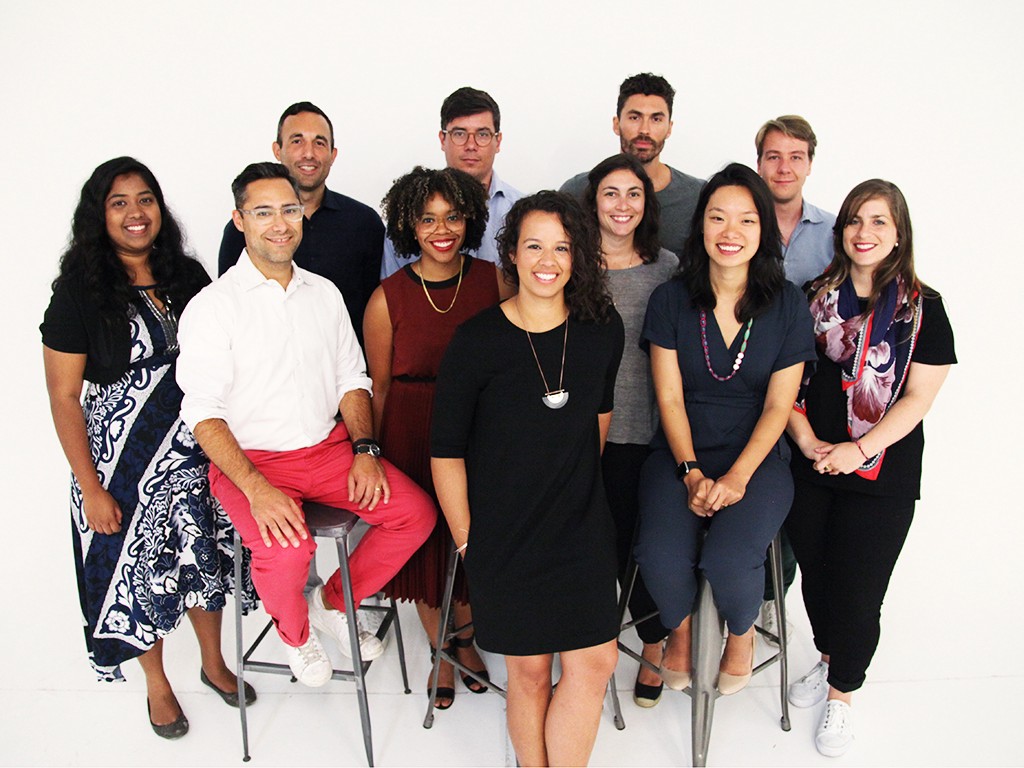
How we’re working
We are continuing to focus our efforts, and business development, on opportunities for enterprise-scale organizational development and transformation. Our ideal project is helping a large, global organization to change the way they work. Client organizations that are a good fit for us tend to have approximately $10 billion or more in annual revenue as for-profit corporations, or approximately $1 billion or more in annual operating budgets as a nonprofit organization.
We are drawn to this scale of client partners for a few reasons. They are a tremendous learning environment. We cross paths with so many different kinds of people and organizational problems through this kind of work. These organizations also have incredible leverage within the global economy. If we can make a small, but meaningful difference in a single Fortune 100 company, we can have a direct impact on the day-to-day work lives of hundreds of thousands of workers, and an indirect impact on millions of consumers and millions more workers at other organizations who might be inspired to follow what our client has done. And — less lofty, but also important — these large organizations are more likely to have budget available to spend with consulting partners like us to help them transform. We believe that all of these factors help to accelerate our ability to pursue our purpose.
To do this work, we are building a team with the following mix of skills:
- IP/Theory: applied knowledge about the underlying theory that informs our work (e.g. org development, org psychology, change management, agile, scrum, lean startup, self-management, etc.)
- Consulting: client relationship management and consulting services
- Delivery/Practice: team coaching, facilitation, and training
- Talent Network: relationships with other potential team members and collaborators
- Client Network: relationships with potential clients and referrers
- Teaming: the ability to collaborate and improve the capacity of those you work with
- Finance Admin: bookkeeping, business modeling, and financial forecasting
- HR Admin: compensation, benefits, hiring, onboarding and offboarding, managing personal employee issues
- Legal Admin: client contracts, employment contracts, immigration, corporate bylaws, corporate structure
- Operations: office management, events, tools and technology
We are still, slowly, making progress on how different capacity levels are defined for each of these areas. We believe that for our transparent and participatory compensation system to work, we will need for the different capacity levels to be defined as explicitly and objectively as possible.
Here’s a snapshot of our current open compensation system.
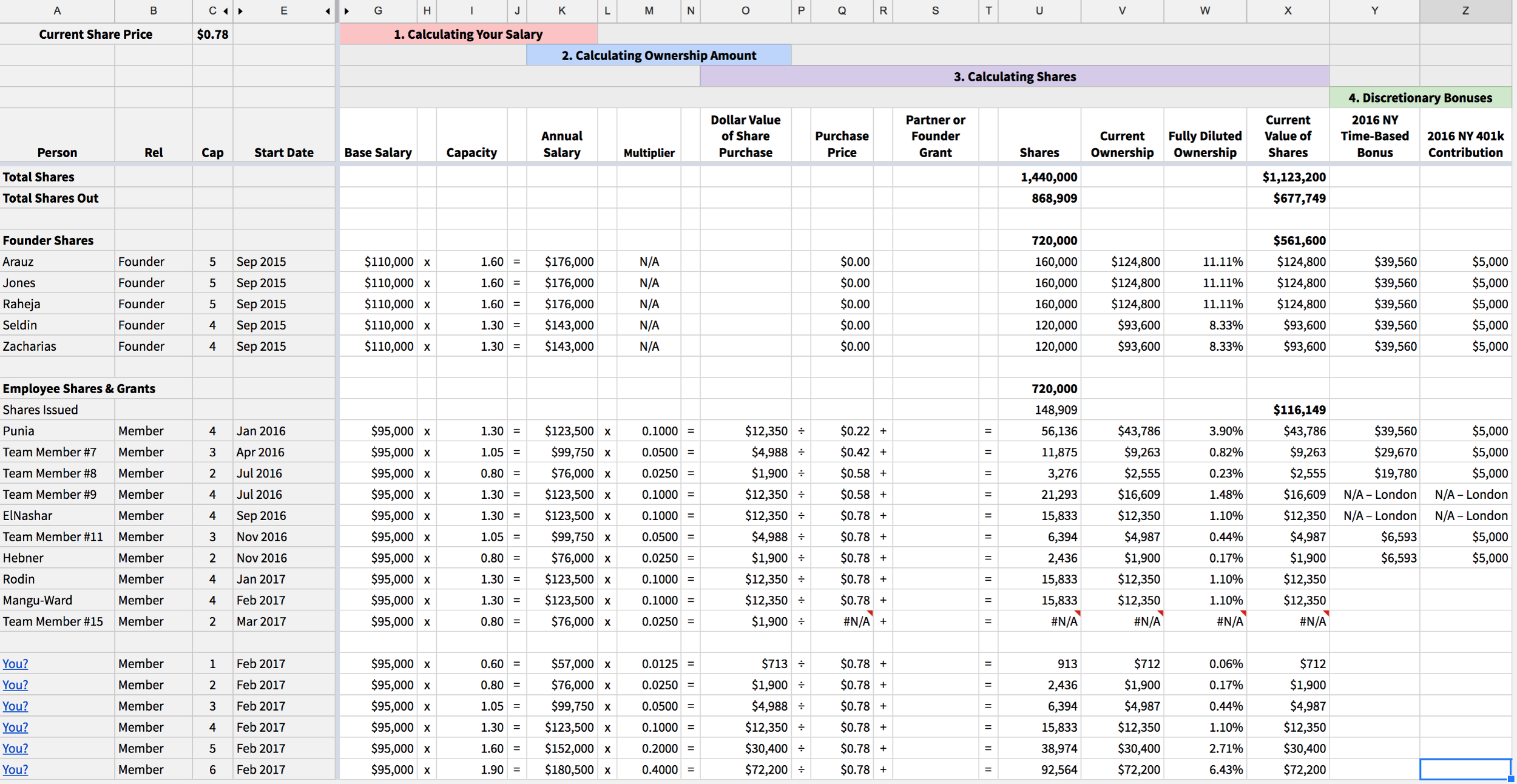
While every team member’s individual compensation is transparent internally to the rest of the team, we’ve made it optional for individuals to share their individual compensation externally. This is why you see some people labeled with their last name, and others labeled as “Team Member”.
August operates on a 4-month cadence, with smaller incremental rhythms for different teams and types of team meetings.
Trimesters: As a default, all major decisions, roles, strategies, and plans are revisited at least once every 4 months, beginning January and ending December of each year.
Summit Week: In between each trimester, the team takes 1 week off from all client work, and focuses on internal org development. We use this time to check-in on our purpose, for special training, for strategic alignment, and to regroup and refocus as a team.
Cycles: Each trimester is divided into 4, 4-week long periods called “cycles”. All client engagements run on the same calendar, with projects across clients starting and stopping on the same cycle dates.
Governance Meeting: Each team meets approximately once per month to propose and commit to changes in how the team does its work, including roles, responsibilities, and policies.
Action Meeting: Each team meets once per week to prioritize their work, and assign tasks.
Weekly Check-In: The entire organization gathers once per week on Monday to check-in with each other on the week ahead.
Weekly Check-out: The entire organization gathers once per week on Friday to check-out, updating each other on how the week went.
Demo Meeting: The entire organization gathers every other Friday to share significant work and other things that the team should be aware of.
In addition to these, we’re constantly trying out additional ways to come together — both structured and unstructured — that can help us be a more capable team.
Our current tech stack includes (not including client-side tech):
- Gmail
- Google Drive and Docs
- Slack
- Trello
- Glassfrog
- Typeform
- Justworks (PEO Vendor)
- Squarespace
- Soundcloud
- Medium
- HelloSign
- QuickBooksOnline (in NY)
- Xero (in London)
- Expensify
- eShares
- Zoom
Our vendors and partners:
- Rooney Nimmo (Legal)
- EKS&H (U.S. Finance)
- Fitz & Law (UK Finance)
- Stimulus (Video)
- Sandra Y. Hong (Team Photos)
- Ben Wagner (Brand and Identity Design)
Teams and Structure
August is currently organized in the following structure of nested, mission-defined teams. Each team decides for themselves how they do their work. The overall team structure, and each of the teams within it, is revised and edited on a monthly or trimesterly cadence.
Teams
August Public Inc. (Mission: A capable team for every meaningful mission)
August Benefit Limited, aka London office (Mission: Build a London-based team capable of bringing August’s purpose to the UK and Europe)
Business Development (Mission: Drive business opportunities to signature)
Marketing (Mission: Robust talent and business opportunities)
NY Ops (Mission: Create an open, mutual, and for-growth operating foundation for the NY team)
Offering and Delivery (Mission: Making and delivering work that consistently makes us proud and accelerates us toward our purpose)
- Client Team P (Mission: The first Responsive Fortune 100 company)
- Client Team E (Mission: The first Responsive Fortune 100 company)
- Client Team C
Team Development (Mission: A capable team for this meaningful mission)
Current Structure, as of March 2017
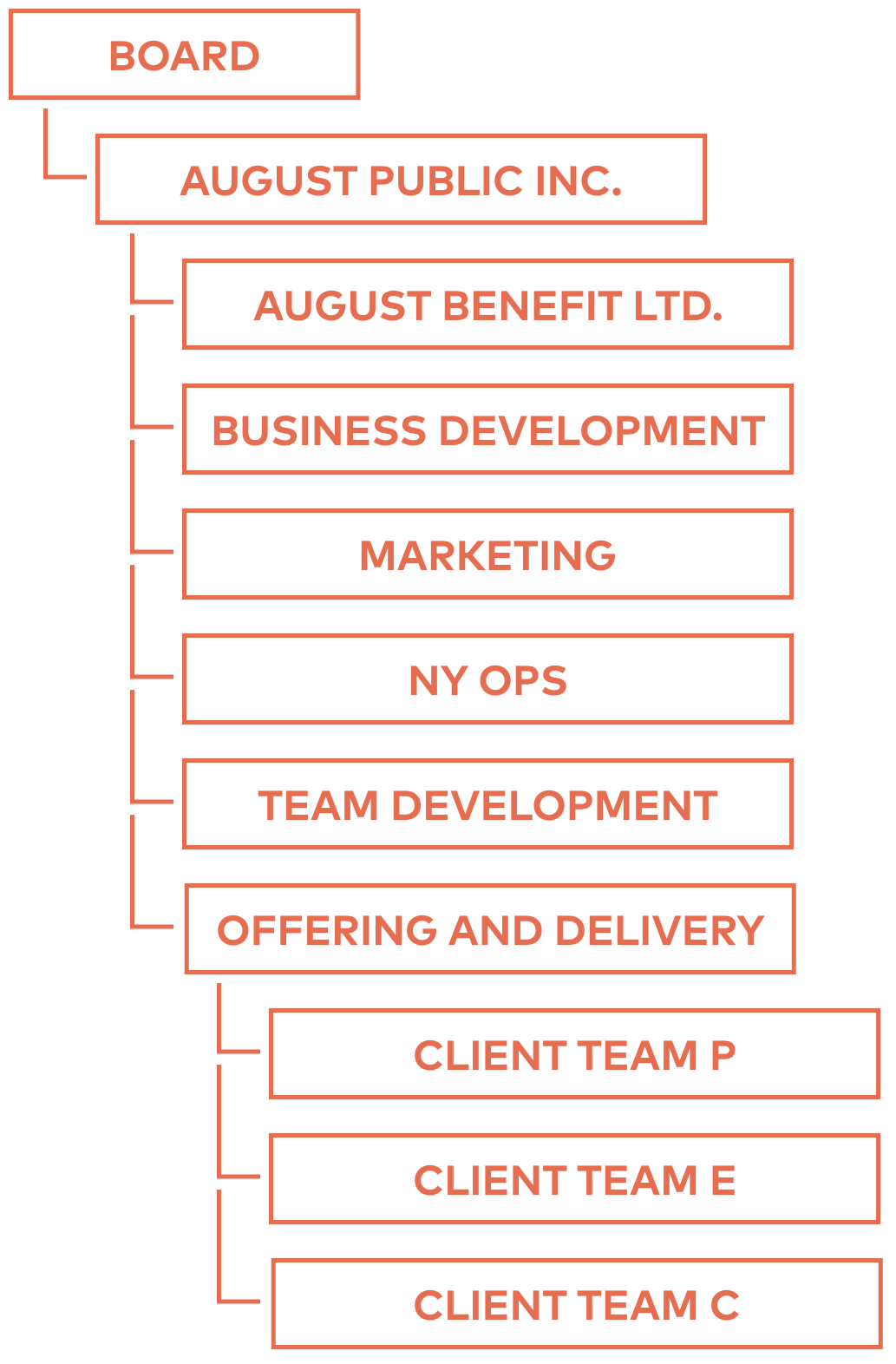
When teams make decisions for themselves about how they intend to do their work, it is recorded as governance in an open, accessible, and editable form. Here are some of the roles and policies we’ve governed that we think are most useful and/or interesting.
Notable governance
- Role-Filling — how we decide who fills which role
- Exit Committee — role responsible for people leaving the organization
- Departures — process for people leaving the organization
- Summit Guide — rotating team responsible for planning Summit Week
- Lead Acceptance and Qualification — how we decide which clients to pursue work with
- Referral Agreement — standard agreement for people who want to introduce us to new clients
- Onboarding Buddy — role responsible for getting new team members up to speed
- New Team Member — general role to help new people get acclimated
- Hiring Process — our process for making hiring decisions
- Hiring Advocates — a role with the responsibility to guide candidates through the hiring process, and make final decisions on making an offer
- Feedback — process for giving and receiving feedback
- Teaming Coach — role responsible for helping with interpersonal and group dynamics within teams
- Personal Coach — role responsible for 1:1 professional coaching
- 90-day commitment — process for evaluating a mutual commitment between a new team member and the organization at the end of their first 90 days
- 90-day letter — practice of sharing your reflections and advice at the end of a team member’s first 90 days
Checking in on last year’s goals
Here are a few things that we said we thought we wanted to improve, as of Feb 2016. This was before we were doing any formal, participatory governance. Some of these items were adopted as explicit goals or missions, and some weren’t. One year later, some of these things clearly make a significant difference to our business; and some don’t. We made progress on some things; we didn’t make progress on other things.
Increase the diversity of perspectives at the board level
- Significant? Very!
- Did we make progress? We did not make much progress on this, as we deprioritized the formation of the new board with external members. We’re aiming to make progress on this in 2017.
Increase the diversity of the people in our talent pipeline
- Significant? Very!
- Did we make progress? Yes! You can read more about our efforts on this front on this post: Tackling Team Diversity: Tactics, Lessons, and Data
Make it easy for great candidates to say ‘yes’ to joining our team
- Significant? Yes
- Did we make progress? Yes. We did a lot of work on our hiring process, and have seen a significant improvement in our recruiting and hiring efforts.
Build relationships with HR executives and business leaders at Fortune 1000 organizations
- Significant? Yes
- Did we make progress? Yes
Figure out how to make the initial introduction to responsive ways of working the BEST WORK EXPERIENCE EVER!
- Significant? Yes
- Did we make progress? A little bit
Make it easy for people within a client organization to discover, learn, and adopt responsive ways of working without our assistance
- Significant? Yes
- Did we make progress? A little bit (we experimented a lot with video and other online learning resources)
Improve our ability to work behind the corporate firewall, making the most of corporate IT-approved tools and software
- Significant? Yes
- Did we make progress? Yes (We’ve done a lot of work in a Microsoft software environment, and have been able to help our clients adopt new work behaviors in spite of Microsoft’s shortcomings.)
Develop relationships with established responsive software providers (Microsoft, Google Docs, Box, Atlassian, Trello, Asana, Slack, etc.)
- Significant? Not really
- Did we make progress? Not really
Turn what we’ve applied and learned into tools for others
- Significant? Yes
- Did we make progress? A little bit
Make it easier for clients who have never worked with us before to get started
- Significant? Yes
- Did we make progress? Not really
Manage our cashflow so that we can increase our risk tolerance for adding new team members, making strategic investments, and spending on growth
- Significant? Yes
- Did we make progress? Yes! (we had great success in growing the team, and making it possible to go after new opportunities like the London office)
The biggest reason we make all of this information public is that we hope others will copy/paste the stuff you like, and iterate and improve on what we’ve done.
We hope that other organizations that are aligned with our purpose do the same. We look forward to learning together!
If you care about making the future of work more human and changing the way organizations operate, subscribe to our weekly newsletter and get in touch.

